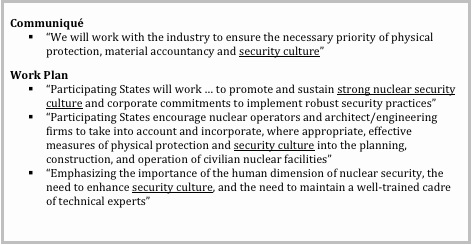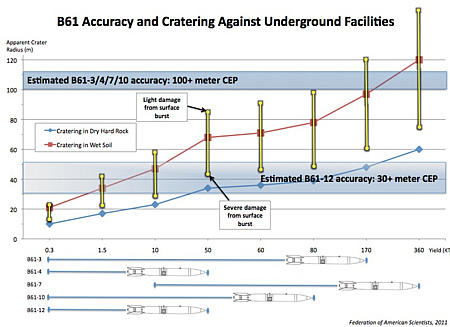Nuclear Plan Conflicts with New Budget Realities
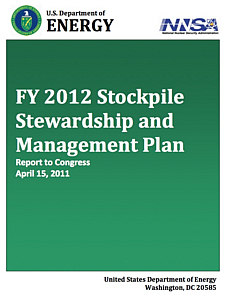 |
| Click on image to download document. |
.
By Nickolas Roth, Hans M. Kristensen and Stephen Young
Note: This is the first of four posts analyzing the FY 2012 Stockpile Stewardship Management Plan, each jointly produced by the Federation of American Scientists and Union of Concerned Scientists. See the other posts here: 2, 3, 4.
A new nuclear weapons plan from the National Nuclear Security Administration (NNSA), which seeks further increases in spending over the next decade for nuclear weapons and for weapons production and simulation facilities, will face real challenges in the new budget environment.
The FY2012 Stockpile Stewardship and Management Plan (SSMP), which was sent to Congress in April, is NNSA’s outline of its near- and long-term plans and associated costs for the U.S. nuclear weapons stockpile and supporting infrastructure. However, with national security spending facing real cuts below FY2011 levels for the next two years at a minimum, either the NNSA must overcome that trend or cut back on its plans.
The FY2012 SSMP is unclassified but has two secret annexes. The new plan updates, with input from Congress, the FY2011 SSMP published last year, and is the first plan to fully incorporate the recommendations of the Obama administration’s 2010 Nuclear Posture Review.
Increased Nuclear Weapon Spending
The Obama administration has significantly increased the amount of money the United States spends on nuclear weapons, and had planned further increases before the Budget Control Act of 2011 was passed last month. The FY2011 budget proposed in early 2010 increased NNSA’s spending on Weapons Activities by nearly 10 percent relative to the previous year, and the administration later added another $5.4 billion for the 2011-2015 future years nuclear security program. According to the FY2011 SSMP, NNSA planned to spend about $80 billion from 2011 through 2020—or an average of $8 billion per year. In comparison, nuclear weapons budgets in the last years of the Bush administration were around $6.7 billion annually in inflation-adjusted dollars.
The FY2012 SSMP shows that the NNSA plans additional funding increases, beginning with an additional $4 billion for the 2012-2016 future years nuclear program. The NNSA now plans to spend $88 billion on nuclear weapons and the nuclear weapons complex from 2012 to 2021, for a yearly average of $8.8 billion. This is another 10% increase on top of the FY11 SSMP increase.
However, those budget levels may be less than what is required if NNSA’s plans do not change. In particular, cost estimates for two major facilities—the Uranium Processing Facility (UPF) in Oak Ridge, Tennessee and the Chemistry and Metallurgy Research Replacement-Nuclear Facility (CMRR-NF) in Los Alamos, New Mexico—are a cause for concern. The NNSA estimates that the UPF could cost $4.2 billion to $6.5 billion, and the CMRR $3.7 billion to $5.8 billion. The FY12 SSMP hints that the total for both might reach $12 billion, but a footnote in Table 6 on page 67 explains that the ten-year budgets above are based on those facilities coming in at the low end of the current cost estimates. Yet a recent independent estimate by the Army Corps of Engineers concluded that the cost of the UPF alone would be between $6.5 and $7.5 billion, which puts the low end equal to the high end of NNSA’s current estimate.
| NNSA Nuclear Weapons Budget Projection 2012-2031 |
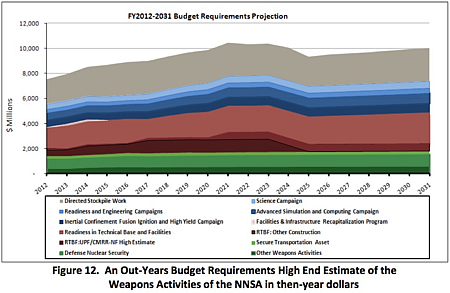 |
| Click on image for larger version. Source: U.S. Department of Energy, National Nuclear Security Administration, FY 2012 Stockpile Stewardship and Management Plan Report to Congress, April 15, 2011, April 2011, p. 68. |
.
The budget requirements projection for FY12-31 above (Figure 12, taken directly from the FY12 SSMP) provides a budget estimate based on the high end of NNSA’s assumptions for all its costs. The chart indicates that the NNSA plans to spend over $120 billion between FY12 and FY24, when the CMRR and UPF are scheduled to be completed. Based on NNSA’s history, using these high end figures is probably a safe assumption, if not an underestimate.
Gone from the FY2012 SSMP is the controversial statement made in the previous SSMP that “the costs to maintain capabilities necessary to support the stockpile are essentially independent of the size of the stockpile.” (Annex D, p. 2.) Yet it is clear from the new plan and other documents that the significant reduction of the U.S. nuclear weapons stockpile since 2004 has not resulted in any savings in NNSA’s budget, which will continue to increase due to more ambitious warhead modernization plans, cost overruns for the construction of new production facilities, and new simulation and testing facilities. The FY2012 SSMP shows that NNSA would like this trend to continue through the 2020s. See the chart below.
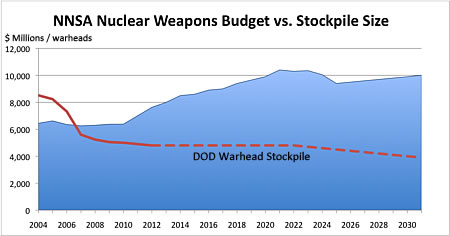 |
| While the size of the nuclear weapons stockpile has declined significantly since 2004, NNSA’s nuclear weapons budget has increased and is projected to grow considerably through the next two decades. Source: NNSA FY12 SSMP; Hans M. Kristensen, Federation of American Scientists. |
.
That desire conflicts with the realities of the Budget Control Act. Rather than a second 10% budget increase as laid out in the FY12 SSMP, the Act calls for a half-percent decrease in national security spending across the board. The House has already passed its version of the key appropriations bill that provides NNSA funding, exacting roughly a 7% cut below the administration’s request for FY2012, leaving a budget less than 3% greater than the FY11 level. The version passed by the Senate appropriations committee was approximately 6% below the request, modestly higher than the House. Because of the Act’s limits, for at least the next several years, NNSA is likely to maintain that level of funding rather than the increased budgets it proposes in the FY12 SSMP.
In short, to live within the new budget priorities that Congress and the administration agreed to in August, NNSA must make significant changes in the timing, scale, and extent of several major projects. Delays, downsizing and perhaps even cancellation of some current priorities seem almost inevitable. The question is: who will make these choices? Will it be the NNSA, the White House, or Congress? And how soon will these decisions be made?
About the authors: Nickolas Roth is Policy Fellow for the Center for Arms Control and Non-Proliferation and a graduate student at the University of Maryland, Hans M. Kristensen is the Director of the Nuclear Information Project at the Federation of American Scientists, and Stephen Young is a Senior Analyst at Union of Concerned Scientists.
See also FY2011 Stockpile Stewardship Management Plan analysis
This publication was made possible by a grant from Carnegie Corporation of New York and Ploughshares Fund. The statements made and views expressed are solely the responsibility of the author.
2012 Nuclear Security Summit in Seoul: Achieving Sustainable Nuclear Security Culture
By Igor Khripunov
According to the International Atomic Energy Agency (IAEA), nuclear security culture is “the assembly of characteristics, attitudes and behavior of individuals, organizations and institutions which serves as a means to support and enhance nuclear security.”[1] The concept of security culture emerged much later than nuclear safety culture, which was triggered by human errors that led to the Three Mile Island, Chernobyl and Fukushima accidents. Much as these incidents confirmed the importance of nuclear safety, security culture has gained acceptance as a way to keep terrorist groups from acquiring radioactive materials and prevent acts of sabotage against nuclear power infrastructures. Safety and security culture share the goal of protecting human lives and the environment by assuring that nuclear power plants operate at acceptable risk levels.
The 2010 Nuclear Security Summit held in Washington, DC, emphasized the importance of culture as a critical contributing factor to nuclear security:
Pentagon’s 2011 China Report: Reducing Nuclear Transparency
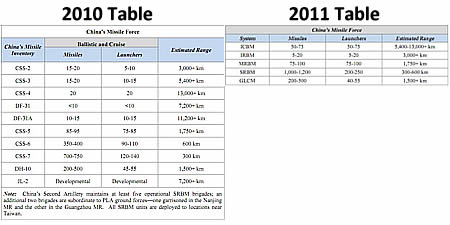 |
| The Pentagon’s new report on China’s military forces significantly reduces transparency of China’s missile force by eliminating specific missile numbers previously included in the annual overview. |
.
By Hans M. Kristensen
The Pentagon has published its annual assessment of China’s military power (the official title is Military and Security Developments Involving the People’s Republic of China). I will leave it to others to review the conclusions on China’s general military forces and focus here on the nuclear aspects.
Land-Based Nuclear Missiles
The most noticeable new development compared with last year’s report is that the Pentagon this year has decided to significantly reduce the transparency of China’s land-based nuclear missile force. For the past decade, the Pentagon reports have contained a breakdown of Chinese missiles showing approximately how many they have of each type. Not anymore. This year the details are gone and all we get to see are the overall numbers within each missile range category: ICBMs, IRBM, MRBM, SRBM, and GLCMs.
This is something one would expect the Chinese government to do and not the Pentagon, which has spent the last decade criticizing China for not being transparent enough about its military posture.
What the numbers we’re allowed to see indicate is that China’s missile force has been largely stagnant over the past year. The changes have been in minor adjustments, probably involving:
- Phasing out a few older DF-4s and introducing a few more DF-31 and DF-31A ICBMs.
- Reducing the DF-3A force and replacing it with the DF-21 MRBMs (which appears largely unchanged but with greater uncertainty).
- Essentially no increase in number of SRBMs off Taiwan.
- The same number of DH-10 GLCMs.
| Addition: Some news media reports unfortunately misrepresent what the Pentagon report says about Chinese nuclear developments:Washington Times (8/25/11)
Claim: “China expanding its nuclear stockpile” (headline) Fact: The Pentagon report says nothing about China expanding its nuclear stockpile (the word “stockpile” does appear in the report at all) but that it is “qualitatively and quantitatively improving its strategic missile forces.” But it is a “limited nuclear force.” Claim: “Richard Fisher, a China military-affairs analyst, said the report is significant for listing strategic nuclear forces that show an estimated increase of up to 25 new ICBMs, some with multiple warheads, in a year….” Fact: The Pentagon report lists 50-75 and 55-63 ICBMs (both ranges are listed). The medium values are 59-62 ICBMs. The 2010 report listed 53-63 (58) ICBMs. That is an increase of 1-4 ICBMs, not 25, which is the highest end of the estimate. The Pentagon report does not say that China has deployed ICBMs with MIRV, but that it “may be” developing a new mobile ICBM, “possible capable of carrying” MIRV. China has been researching MIRV since the 1980s but so far not chosen to deploy any. The one thing that could drive China to a decision to potentially deploy MIRV in the future would be a U.S. ballistic missile defense system that diminished the effectiveness of China’s nuclear deterrent. Claim: (Fisher) “China will not reveal its missile-buildup plans…so this simply is not the time to be considering further cuts in the U.S. nuclear force, as is the Obama administration’s intention.” Fact: The United States has 5,000 warheads, China 240. Only about 60 of the Chinese warheads can reach the United States, and only half of those can reach all of the United States. Claim: “Advanced China n-missiles on India border, says Pentagon” (headline) Fact: The Pentagon report does not state that China has deployed nuclear missiles on the Indian border. Instead, the report states in general terms that “To strengthen deterrence posture relative to India, the PLA has replaced” DF-3As “with more advanced and survivable” DF-21s. This is a reference to the DF-21 replacing outdated DF-3A brigades at Chuxiong, Jianshui and Kunming in the Yunnan province and near Delingha and Da Qaidam in the Qinghai province. |
.
Trying to reconstruct the table the way it should have been comes with considerable uncertainty, but here is my best estimate (for corrections I will have to rely on individuals in the Pentagon who think that buying into Chinese government secrecy does not advance U.S. or Northeast Asian interests):
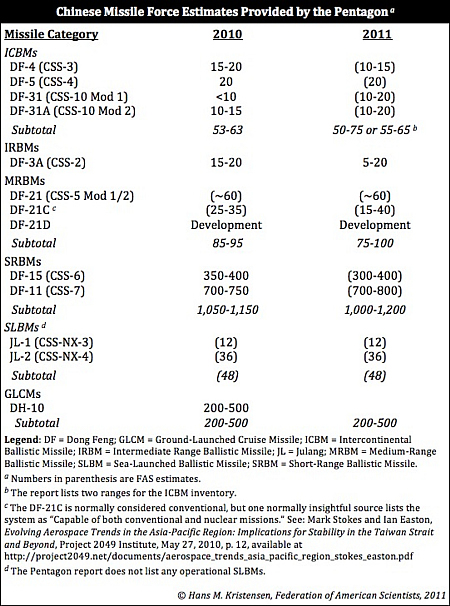 |
| Click on table to download larger version. |
.
Ballistic Missile Submarines
The new Jin-class (Type 094) SSBN appears ready but the Pentagon report states that its JL-2 SLBM “has faced a number of problems and will likely continue flight tests.” The Pentagon previously estimated that the Jin/JL-2 system would become operational in 2010 but the new report now states that it is “uncertain” when the new system will become fully operational.
The range of the JL-2 SLBM is extended, somewhat, from 7,200+ km in the 2010 report to 7,400 km in the 2011 report. This does not change the fact that a Jin-class SLBM would have to deploy deep into the Sea of Japan for its JL-2 to be able to strike the Continental United States. Alaska is within range from Chinese waters, but not Hawaii.
The operational status of the old Xia-class (Type 092) SSBN and its JL-1 SLBM “remain questionable.” Neither class has conducted any deterrent patrols yet.
As a result, China does not appear to have any operational sea-launched ballistic missiles at this point.
The report lists only five nuclear attack submarines with the three fleets, down from six last year, suggesting that retirement of the Han-class (Type 091) continues. The Shang-class (Type 093) is operational, and the Pentagon report states that “as many as five third-generation Type 095 SSNs will be added in the coming years.” The U.S. Navy’s intelligence branch estimated in 2009 that the Type 095 will be noisier than the Russian Akula I but quieter than the Victor III.
Chinese attack submarines conducted 12 patrols during all of 2010, the same level as the previous two years.
Underground Facilities
While there has recently been some sensational reporting (see also here) that China since 1995 has built a 5,000-km “great wall” of tunnels under Hebei mountain in the western parts of the Shaanxi province to hide “all of their missiles hundreds of meters underground,” including the DF-5 (CSS-4) ICBM, the reality is probably a little different.
First, as anyone who has spent just a few hours studying satellite images of Chinese military facilities and monitoring the Chinese internet will know, the Chinese military widely uses underground facilities to hide and protect military forces and munitions. Some of these facilities are also used to hide nuclear weapons. The old DF-4, for example, reportedly has existed in a cave-based rollout posture since the 1970s.
The Pentagon report states that China has “developed and utilized UGFs [underground facilities] since deploying its oldest liquid-fueled missile systems and continue today to utilize them to protect and conceal their newest and most modern solid-fueled mobile missiles.” So it is not new but it is also being used for modern missiles.
| Chinese Underground Missile Launcher Facility |
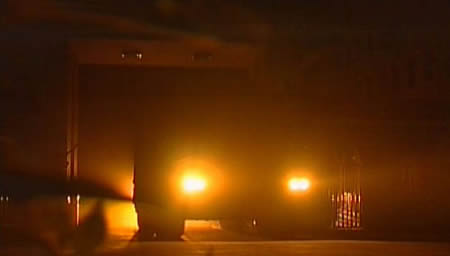 |
| A Chinese mobile missile launcher, possibly for the DF-11 or DF-15 SRBM, emerges from an underground facility at an unknown location. Image: Chinese TV |
.
Second, the particular facility under Hebei mountain appears to be China’s central nuclear weapons storage facility, as recently described by Mark Stokes. The missiles themselves are at the regional bases, although it cannot be ruled out that some may be near Hebei as well. But Stokes estimates that the warheads are concentrated in the central facility with only a small handful of warheads maintained at the six missile bases’ storage regiments for any extended period of time. The missile regiments themselves could also have nearby underground facilities for storing launchers and missiles, although specifics are not known.
One of the Chinese bases with plenty of underground facilities is the large naval base near Yulin on Hainan Island, which I described in 2006 and 2008. The Pentagon report concludes that this base has now been completed and asserts that it is large enough to accommodate a mix of attack and ballistic missile submarines and advanced surface combatants, including aircraft carriers. The report adds that, “submarine tunnel facilities at the base could also enable deployments from this facility with reduced risk of detection.” That would seem to require the submarine exiting from the tunnel submerged; a capability I haven’t seen referenced anywhere yet.
Conclusions
The 2011 Pentagon report shows that China’s nuclear missile force changed little during the past year but appears to continue the slow replacement of old liquid-fueled missiles with new solid-fueled missiles. China’s efforts to develop a sea-launched ballistic missile capability have been delayed.
In an unfortunate change from previous versions of the Pentagon report, the 2011 version significantly reduces the transparency of China’s nuclear missile forces by removing numbers for individual missile types. This change is particularly surprising given the Pentagon’s repeated insistence that China must increase transparency of its military posture. In this case, military secrecy appears to contradict U.S. foreign policy objectives.
The decision to reduce the transparency of China’s missile force is even more troubling because it follows the recent U.S.-Russian decision to significantly curtail the information released to the public under the New START treaty.
The combined effect of these two decisions is that within the past 12 months it has become a great deal harder for the international community to monitor the development of the offensive nuclear missile forces of the United States, Russia and China.
Tell me again whose interest that serves?
See also: 2010 Pentagon Report on China
This publication was made possible by a grant from Carnegie Corporation of New York and Ploughshares Fund. The statements made and views expressed are solely the responsibility of the author.
Rewriting US Presidential Nuclear War Planning Guidance
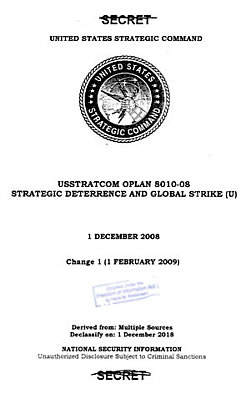 |
| How will Obama reduce the role of nuclear weapons in the strategic war plan? |
.
By Hans M. Kristensen
The Obama administration has begun a review of the president’s guidance to the military for how they should plan for the use of nuclear weapons. The review, which was first described in public by National Security Advisor Tom Donilon, is the ultimate test of President Obama’s nuclear policy; the rest is just words: to what extent will the new guidance reduce the role of nuclear weapons in the war plan?
Although the administration’s Nuclear Posture Review is widely said to reduce the role of nuclear weapons, it doesn’t actually reduce the role that nuclear weapons have today because all the adversaries in the current strategic nuclear war plan are exempt from the reduction. They are either nuclear weapon states, not members of the nuclear Non-Proliferation Treaty, or are in violation of their NPT obligations and have chemical or biological weapons. The new guidance would have to remove some of these adversaries from the war plan to reduce the role, or reduce the role that nuclear weapons are required to play against each of them. There are many ways this could be done:
- Reduce the numer of target categories that are held at risk with nuclear weapons.
- Reduce the damage expectancy to be a achieved against individual targets.
- Reduce the number of adversaries in the plan.
- Reduce the number and types of strike options against each adversary.
- Remove the requirement to plan for prompt launch of nuclear forces.
- Remove any requirement to plan for damage limitation strikes.
- End counterforce nuclear planning.
- End the requirement to maintain standing fully operational strike plans.
Reducing the role of nuclear weapons in the war plan requires direct and continuous presidential attention to avoid that the commitments to reducing the number and role of nuclear weapons are watered down by bureaucrats and cold warriors in the National Security Council, Department of Defense, military commands and Services, as well as former officials who are busy lobbying against a reduction.
To support president Obama’s vision of dramatically reduced nuclear arsenals and a reduced role of nuclear weapons on the way to deep cuts of nuclear weapons and eventually disarmament, we published a study in 2009 that proposed a transition from counterforce planning to what we called a minimal deterrent. A study from 2010 further described the current strategic nuclear war plan (OPLAN 8010-08 Change 1 from February 1, 2009 – this plan is still in effect). Building on those two studies, we have a new op-ed in the Bulletin of the Atomic Scientists that describes what a new presidential directive could look like: A Presidential Policy Directive for a new nuclear path.
This publication was made possible by a grant from Carnegie Corporation of New York and Ploughshares Fund. The statements made and views expressed are solely the responsibility of the author.
Anatomizing Non-State Threats to Pakistan’s Nuclear Infrastructure
The discovery and subsequent killing of Osama bin Laden in Abbottabad, Pakistan raises troubling questions. The success of the U.S.’s airborne raid on bin Laden’s compound-undetected by Pakistan’s radar- lends credence to the belief that terrorists might be capable of successfully seizing Pakistan’s nuclear weapons.
Mr. Charles P. Blair has authored a new FAS report (PDF) that addresses the security gap and identifies specific terrorists within Pakistan who are motivated and potentially capable of taking Pakistani nuclear assets. Blair explains in the report details why, amid Pakistan’s burgeoning civil war, the Pakistani Neo-Taliban is the most worrisome terrorist group motivated and possibly capable of acquiring nuclear weapons.
20th Anniversary of START
July 31st is the 20-year anniversary of signing of the Strategic Arms Reduction Treaty (START) between the United States and the Soviet Union. The treaty, also known as START I, marked the beginning of a treaty-based reduction of U.S. and Soviet (later Russian) strategic nuclear forces after the end of the Cold War.
START I required each country to limit its number of accountable strategic delivery vehicles (ballistic missiles and long-range bombers) to no more than 1,600 with no more than 6,000 accountable warheads. The treaty came with a unique on-site inspection regime where inspectors from the two countries would inspect each other’s declared force levels. Thousands of other warheads were not affected and the treaty did not require destruction of a single nuclear warhead. START I entered into effect on December 5th, 2001, and expired on December 4, 2009.
Twenty years after the signing of START I, the United States and Russia are still in the drawdown phase of their strategic nuclear forces: START II followed in 1993, limiting the force levels to 3,500 accountable warheads by 2007 with no multiple warheads on land-based missiles; START II was never ratified by the U.S. Senate but surpassed by the Moscow Treaty in 2002, limiting the number of operationally deployed strategic warheads to 2,200 by 2012; The Moscow Treaty was replaced by the New START treaty signed in 2010, which limits the number of accountable strategic warheads to 1,550 on 700 deployed ballistic missiles and long-range bombers by 2018. Like its predecessors, New START does not limit thousands of non-deployed and non-strategic nuclear warheads and does not require destruction of a single warhead.
The Obama administration has stated that the next treaty must also place limits on non-deployed and non-strategic nuclear warheads.
This publication was made possible by a grant from Carnegie Corporation of New York and Ploughshares Fund. The statements made and views expressed are solely the responsibility of the author.
Norway’s Anders Brevik: Weapons of Mass Destruction and the Politics of Cultural Despair
ABOUT THIS REPORT (click to show)
At some point, most security analysts face the dilemma of balancing expediency with analytical thoroughness. Such is the case with Norway’s Anders Breivik. As his victims await burial, Breivik’s treatise—the 1500 page, 2083:
A European Declaration of Independence (click here for PDF link)—became available only a few days ago. While some researchers, mindful of the value of analytical completeness, patiently plod through this massive manifesto, analysts at the Federation of American Scientists (FAS) conclude that the nature of Breivik’s attacks, compounded with the extraordinary content of his treatise, raise questions of such immediate concern that the formulation and release of initial analyses are prudent. We present such an effort here as both a highly formatted blog post and as a preliminary report. The former allows for a quick delivery of our preliminary investigation amid a platform for open discussion of a threat that remains, we believe, largely inchoate. The latter conforms to our professional dedication to robust research and application of various relevant analytical methodologies.
While Breivik’s unprecedented attacks alone warrant profound study, his treatise seeks to portend far greater acts of terror and destruction than those visited upon Norway on July 22nd. However, to date, no substantive effort addresses the document’s detailed exposition of the fabrication, delivery and general merits of chemical, biological, radiological and nuclear weapons (CBRN). The paucity of concern and immediacy revolving around Breivik’s assertions of forthcoming CBRN attacks likely result from two interrelated issues. First, Breivik is incarcerated and will likely remain so for the rest of his life; Breivik himself is no longer a threat. Second, some question his technical acumen with regard to CBRN; even if he were free, according to one putative CBRN expert, “Breivik’s WMD idea is not realistic.”[1] We
largely agree with such conclusions. However, any proper risk assessment must conduct a so-called “assumptions check.” Such an exercise has two primary elements: 1) explicitly identifying conclusions that rely, in part or in whole, on assumptions and 2) identifying and evaluating the consequences should such assumptions prove false.[2] Application of an assumptions check to the Breivik case, we believe, precipitates the need for serious and immediate analyses of the treatise’s content for two primary reasons.
First, Breivik has made claims, through his writing as well as to Oslo District Court Judge Kim Heger, that he is in league with extremist cells and that some of these co-conspirators “are already in the process of attempting to acquire chemical, biological, radiological, or nuclear materials.”[3] While it is likely that Breivik acted alone, we are not comfortable assuming that this is the case. Moreover, given the operational sophistication of his attacks, and, among other salient components in the case writ large, the overall operational security that he maintained for years, it is axiomatic that Breivik’s threats should be considered in great detail. Indeed, as renowned terrorism expert Gary Ackerman has warned, “History is replete with cautionary tales warning against basing threat assessments on static analyses of an opponent’s motivations and capabilities.”[4] In short, it is possible that subsequent attacks—some perhaps even utilizing CBRN—may be forthcoming, and it is therefore prudent for the intelligence communities to carefully consider Breivik’s writings.
Second, our initial analyses of Brevik’s comprehension of the relevant issues surrounding the fabrication and employment of CBRN concludes that he was motivated and capable of credibly pursuing low-end CBRN attacks—specifically those likely to result in mass effect as opposed to mass destruction . As our report details, this is specifically the case with some biological and radiological agents. Should Breivik be part of a cell of violent extremists, it is possible that his confederates share an equal, if not greater, understanding of the technologies underlying certain CBRN. Moreover, they may have access to the necessary agents and technologies necessary to actualize Breivik’s more ambitious stratagems for the employment of CBRN.
We are presently inclined to conclude that Breivik acted alone. Consequently, his warnings of forthcoming CBRN events are likely invalid. However, given the nature of his attacks and the content of his treatise we urge the security community to seriously consider the possibility that cells of violent extremists are linked to Breivik; the pursuit of a CBRN capability—as well as the possibility of radiological and/or biological use—are a possibility.
Blog posts and reports from the FAS Terrorism Analysis Project are produced to increase the understanding of policymakers, the public, and the press about threats to national and international security from terrorist
groups and other violent non-state actors. The reports are written by individual authors—who may be FAS staff or acknowledged experts from outside
the institution. These reports do not represent an FAS institutional position on policy issues. All statements of fact and expressions of opinion contained in this and other FAS-published reports are the sole responsibility of the author or authors.
See “Alleged Norway Shooter Considered WMD Attack, Jihadi Alliance,” ABC News,
July 24, 2011. Available at: http://abcnews.go.com/Blotter/anders-breivik-alleged-norway-shooter-considered-wmd-attack/story?id=14148151
Whether we are conscious of it or not, most of us frequently conduct an
assumptions check. For example, imagine that as you are about to lie down in
bed for a night of sleep you suddenly realize that you cannot be sure if you
locked your car doors. You might temporarily assume you did; however,
you mind quickly assesses the consequences of a faulty assumption.
Whether or not you get up, get dressed, and trudge out to your car is largely
the result of the risk assessment you make should the car be unlocked.
Andrew Berwick [pseudonym for Anders Behring Breivik], 2083 A European
Declaration of Independence, July 2011, 1022.
United States Senate Committee on Homeland Security
and Governmental Affairs Hearing on “Nuclear Terrorism: Assessing the Threat to
the Homeland.” Testimony of Gary A. Ackerman, April 2, 2008, 3.
Available at: http://hsgac.senate.gov/public/_files/040208Ackerman3.pdf
Norway’s Anders Brevik: Weapons of Mass Destruction and the Politics of Cultural Despair
CHARLES P. BLAIR, KELSEY GREGG, AND JONATHAN GARBOSE[ref]The authors thank Rebecca A. Remy for her valuable research assistance.[/ref]
July 27, 2011
Ten years after the events of 9/11, it is often forgotten that high fatality terrorist incidents remain a rarity. Indeed, prior to 9/11 the single deadliest terrorist attack was the 1978 Iranian theatre firebombing perpetrated by Mujahedin-e Khalq (MEK: People’s Majahedin of Iran) with 470 fatalities. Since 1970, only 118 incidents of terrorism have killed more than 100 people—0.12 percent of the 98,000 terrorist events encompassing that four decade span. As the death toll of the July 22 attacks in Norway approaches 100, it is useful to appreciate this fact. In addition to recognizing their uncommonly deadly outcomes, two other features related to the attack are salient. First, significant elements of Anders Breivik’s treatise—the 1500 page 2083: A European Declaration of Independence [ref]Andrew Berwick, pseudonym for Anders Behring Breivik, 2083 A European Declaration of Independence, July 2011, hereafter referred to as The Declaration.[/ref] (click here for PDF link)—address the acquisition, weaponization, and use of chemical, biological, radiological, and nuclear (CBRN) agents or devices against Breivik’s perceived enemies. Second, his ideological platform, said by Breivik to represent his role as “Justiciar Knight Commander for Knights Templar Europe and one of several leaders of the National and pan-European Patriotic Resistance Movement,” is largely informed by European racist ideology that first emerged in the nineteenth century and continues to this day. This report principally evaluates the CBRN elements of Breivik’s treatise. A subsequent report (schedule for release in late 2011) will orient Breivik’s ideological underpinnings within the broader historical milieu of European racist thinking. First, however, it is useful to place Breivik’s attack in perspective.
Panel Discussion at Brookings on NATO Nukes
Steve Pifer was kind enough to invite me to participate in a panel discussion at the Brookings Institution about NATO’s nuclear future and the issue of non-strategic nuclear weapons in the Alliance’s current Defense and Deterrence Posture Review (DDPR).
Steve presented his excellent paper NATO, Nuclear Weapons and Arms Control, Frank Miller, who has been involved in these issue before I could tie my shoe laces, took the “keep US nukes in Europe,” while I argued for the withdrawal of the weapons. Angela Stent moderated the panel.
I’m not yet clear if they’re planning to post a transcript or video, so in the meantime here are my prepared remarks: NATO’s Posture Review and Non-Strategic Nuclear Weapons.
For my writings on this blog about NATO nuclear policy issues, go here.
See also recent letter to NATO Secretary General Ander Fogh Rasmussen coordinated by ACA and and BASIC and signed by two dozen nuclear experts and former senior government officials.
This publication was made possible by a grant from Carnegie Corporation of New York and Ploughshares Fund. The statements made and views expressed are solely the responsibility of the author.
Pakistani Nuclear Forces 2011
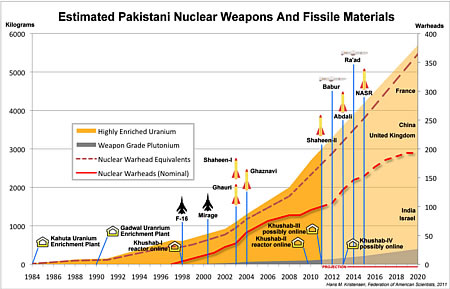 |
| Pakistan’s nuclear arsenal has doubled since 2004 and could double again in the next 10 years if the current trend continues, according to the latest Nuclear Notebook. Click on chart to download full size version. |
.
By Hans M. Kristensen and Robert S. Norris
The latest Nuclear Notebook on Pakistan’s nuclear forces is available on the Bulletin of the Atomic Scientists web site. Since our previous Notebook on Pakistan in 2009 there have been several important developments.
Based on our own estimates, official statements, and fissile material production estimates produced by the International Panel of Fissile Materials, we conclude that Pakistan’s current nuclear weapons stockpile of 90-110 warheads might increase to 150-200 within the next decade. This would bring the Pakistani stockpile within range of the British stockpile, the smallest of the original five nuclear weapon states, but still far from that of France (despite some recent news reports to the contrary).
This development is precipitated by the anticipated introduction of several new nuclear delivery systems over the next years, including cruise missiles and short-range ballistic missiles. The capabilities of these new systems will significantly change the composition and nature of Pakistan’s nuclear posture.
India is following this development closely and is also modernizing its nuclear arsenal and fissile material production capability. The growing size, diversity, and capabilities of the Pakistani and Indian nuclear postures challenge their pledge to only acquire a minimum deterrent. Bilateral arms control talks and international pressure are urgently needed to halt what is already the world’s fastest growing nuclear arms race.
This publication was made possible by a grant from Carnegie Corporation of New York and Ploughshares Fund. The statements made and views expressed are solely the responsibility of the author.
B61 LEP: Increasing NATO Nuclear Capability and Precision Low-Yield Strikes
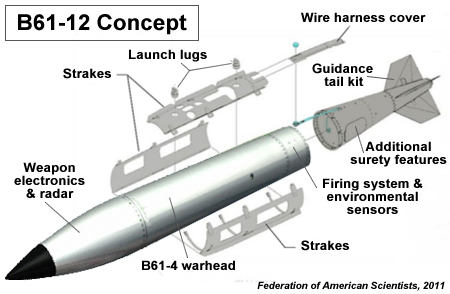 |
| The US military is planning to replace the tail section of the B61 nuclear bomb with a new guided tail kit to increase the accuracy of the weapon. This will increase the targeting capability of the weapon and allow lower-yield strikes against targets that previously required higher-yield weapons. Image: FAS Illustration |
.
By Hans M. Kristensen
A modified U.S. nuclear bomb currently under design will have improved military capabilities compared with older weapons and increase the targeting capability of NATO’s nuclear arsenal.
The B61-12, the product of a planned 30-year life extension and consolidation of four existing versions of the B61 into one, will be equipped with a new guidance system to increase its accuracy.
As a result, if funded by Congress, the U.S. non-strategic nuclear bombs currently deployed in five European countries will return to Europe as a life-extended version in 2018 with a significantly enhanced capability to knock out military targets.
Add to that the stealthy capability of the new F-35 aircraft being built to deliver the new weapon, and NATO is up for a significant nuclear upgrade.
The upgrade would also improve the capability of U.S. strategic bombers to destroy targets with lower yield and less radioactive fallout, a scenario that resembles the controversial PLYWD precision low-yield nuclear weapon proposal from the 1990s.
Finally, the B61-12 will mark the end of designated non-strategic nuclear warheads in the U.S. nuclear stockpile, essentially making concern over “disparity” with Russian non-strategic weapons a non-issue.
The Obama administration and Congress should reject plans to increase the accuracy of nuclear weapons and instead focus on maintaining the reliability of existing weapons while reducing their role and numbers.
Increasing Military Capabilities
It is U.S. nuclear policy that nuclear weapons “Life Extension Programs…will not support new military missions or provide for new military capabilities.” According to this policy stated in the Obama administration’s Nuclear Posture Review (NPR), the B61-12 cannot have new or greater military capabilities compared with the weapons it replaces.
Yet a new report published by the U.S. Government Accountability Office (GAO) reveals that the new bomb will have new characteristics that will increase the targeting capability of the nuclear weapons deployed in Europe.
It is important at this point to underscore that the official motivation for the new capabilities does not appear to be improved nuclear targeting against Russia or other potential adversaries. Nonetheless, that will be the effect.
The GAO report describes that the nuclear weapons designers were asked to “consider revisions to the bomb’s military performance requirements” to accommodate both non-strategic and strategic missions. This includes equipping the B61-12 with a new guided tail kit section in an $800 million Air Force program that is “designed to increase accuracy, enabling the military to achieve the same effects as the older bomb, but with lower nuclear yield.”
The B61 LEP consolidates four existing B61 types (non-strategic B61-3, B61-4 and B61-10, as well as the strategic B61-7) into one, so the new B61-12 must be able to meet the mission requirements for both the non-strategic and strategic versions. But since the B61-12 will use the nuclear explosive package of the B61-4, which has the lowest yield of the four types (a maximum of 50 kt), increasing the accuracy was added to essentially turn the B61-4 into a B61-7 in terms of targeting capability.
| Consolidating Four Bombs Into One |
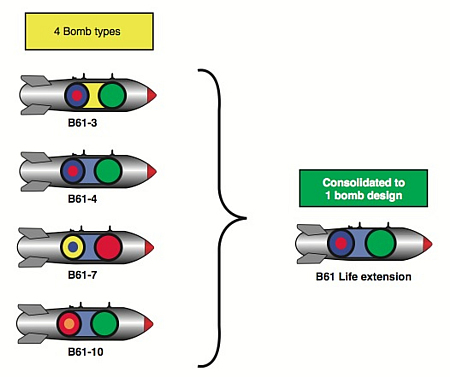 |
| This STRATCOM slide used in the GAO report portrays the B61-12 as a mix of components from existing weapons. The message: it’s not a “new” nuclear weapon. But the slide is missing the most important new component: a new guided tail kit section that will increase the weapon’s accuracy. Image: STRATCOM/GAO |
.
The new guided tail kit – the B61 Tail Subassembly (TSA), as it is formally called – will be developed by Lockheed Martin, Raytheon and Boeing for the Air Force and similar to the tail kit used on the conventional Joint Direct Attack Munition (JDAM) bomb (Boeing has delivered more than 225,000 kits so far). But the B61-12 would be the first time a guided tail kit has been used to increase the accuracy of a deployed nuclear bomb.
The B61-12 accuracy is secret, but officials tell me it is similar to the tail kit on the JDAM (Joint Direct Attack Munition), which uses a GPS (Global Positioning System)-aided INS (Internal Navigation System). In its most accurate mode it provides the JDAM a circular error probable (CEP) of 5 meters or less during free flight when GPS data is available. If GPS data is denied, the JDAM can achieve a 30-meter CEP or less for free flight times up to 100 seconds with a GPS quality handoff from the aircraft. It is yet unclear if the B61-12 will have GPS, which is not hardened against nuclear effects, but many limited regional scenarios probably wouldn’t have sufficient radiation to interfere with GPS.
Officials explain that the increased accuracy will not violate the LEP policy in the NPR because the B61-12 will not have higher yield than the types it replaces. The B61-12 nuclear explosive package (NEP) will be based on the B61-4, which has the lowest maximum yield of the four types to be consolidated. The B61-7, in contrast, has a maximum yield of 360 kt (see table). But while B61-12 does not increase the yield of the B61-7, its guided tail kit will increase the targeting capability compared with the existing B61-3/4 and -10 versions.
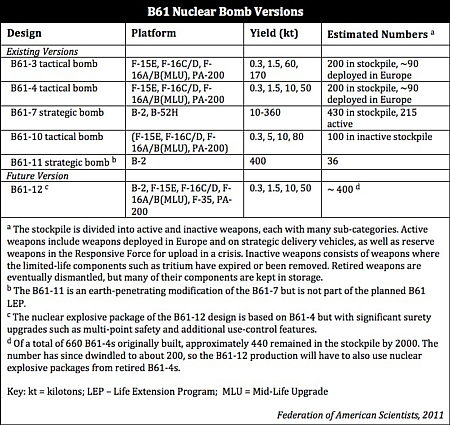 |
| Click on chart to download larger version. |
.
Targeting Implications
Increasing the accuracy of the B61 has important implications for NATO’s nuclear posture and for nuclear targeting in general.
In Europe, the new guided tail kit would increase the targeting capability of the nuclear weapons assigned to NATO by giving them a target kill capability similar to that of the high-yield B61-7, a weapon that is not currently deployed in Europe.
This would broaden the range of targets that can be held at risk, including some capability against underground facilities. In addition, delivery from new stealthy F-35 aircraft will provide additional military advantages such as improved penetration and survivability.
Shock damage to underground structures is related to the apparent (visible) radius of the crater caused by the nuclear explosion. For example, according to the authoritative The Effects of Nuclear Weapons) published by the Department of Defense and Department of Energy in 1977, severe damage to “Relatively small, heavy, well-designed, underground structures” is achieved by the target falling within 1.25 apparent crater radii from the Surface Zero (the point of detonation), and light damage is achieved by the target falling within 2.5 apparent crater radii from the Surface Zero. For a yield of 50 kt – the estimated maximum yield of the B61-12, the apparent crater radii vary from 30 meters to 68 meters depending on the ground (see graph below). Therefore an improvement in accuracy from 100-plus meter CEP (the current estimated accuracy of the B61) down to 30-plus meter CEP (assuming INS guidance) improves the kill probability against these targets significantly by achieving a greater likelihood of cratering the target during a bombing run. Put simply, the increased accuracy essentially puts the CEP inside the crater.
.
The U.S. Department of Defense and NATO agreed on the key military characteristics of the B61-12 in April 2010 – the same month the NPR was published and seven months before NATO’s new Strategic Concept was approved. This included the yield options, that the B61-12 will have both midair and ground-burst detonation options, that it will be capable of freefall (but not parachute-retarded) delivery, and the required accuracy when equipped with the new guided tail section and employed by the F-35. STRATCOM, which provides targeting assistance to NATO, subsequently asked for a different yield, which U.S. European Command and SHAPE (Supreme Headquarters Allied Powers Europe) agreed to. Since the NPR prohibits increasing the military capability, STRATCOM’s alternative B61-12 yield cannot be greater than the current maximum yield of the B61-4.
The GAO report states that “neither NATO nor U.S. European Command, in accordance with the NATO Strategic Concept, have prepared standing peacetime nuclear contingency plans or identified targets involving nuclear weapons.” (Emphasis added). The “no standing plans” claim is correct because regional nuclear strike planning is no longer done with “standing plans” as during the Cold War. But that doesn’t mean there are no plans at all. Today’s strike planning does not require “standing” plans but relies on new adaptive planning capabilities that can turn out a strike plan within days or weeks.
But the “no identified targets” claim raises an obvious question: If NATO and EUCOM have not “identified targets” for the B61 bombs in Europe, how then can they identify the military characteristics needed for the B61-12 that will replace the bombs in 2018? Obviously, some targets have been identified.
The addition of the tail kit eliminates the need for the existing parachute-retarded laydown option, where a parachute deployed from the rear of the nuclear bomb provides for increased accuracy when employed from an aircraft flying at very low altitude (and allows the pilot (and aircraft) to escape the blast). But a GPS/INS tail kit would also give the B61-12 high accuracy independent of release altitude, weather, and axis of aircraft for much greater survivability.
Reinventing PLYWD: Low-Yield Prevision Nuke
Beyond Europe, the guidance tail kit would also have implications for nuclear targeting in general. Although the B61-12 will not be able to exceed the target kill capability of the maximum yield of the B61-7, the increased accuracy will have an effect on the target kill capability at lower yields. Indeed, the B61-12 concept resembles elements of the Precision Low-Yield Weapon Design (PLYWD) program from the early-1990s when the Air Force studied combining low-yield warhead options with precision guidance to reduce collateral damage from nuclear strikes.
 |
| Click on image to download report. |
.
Much of that study remains classified but parts of it were released to me under the Freedom of Information Act (see box). The study concluded that, “The use of precision guidance could permit the Air Force to accomplish some missions as effectively, or more effectively, with low-yield weapons” (emphasis added). Overall, the study found that a precision, low-yield weapon “can be effective against a large fraction of potential targets, can reduce collateral damage on a significant number of targets, is technically feasible, and can provide aircraft standoff (and thus improve survivability).”
PLYWD was rejected by Congress, which banned work on and development of new warheads with a yield of less than five kilotons. Among other things, Congress was concerned that the combination of precision and low-yield to reduce collateral damage would make nuclear weapons appear more useable and risk lowering the nuclear threshold and increase the risk that nuclear weapons would actually be used.
The issue resurfaced in 2001 with proposals to build low-yield nuclear earth penetrators, but the scenarios were shown to be inherently dirty (examples of analysis here, here, and here). Even so, the Bush administration managed to defeat the ban in 2003 in order to explore advanced concepts of nuclear strike options against regional adversaries (see CRS report for background).
The beauty of the B61-12 program is that it avoids a controversial decision to develop a new low-yield nuclear warhead but achieves many of the PLYWD mission goals by combining the existing lower-yield options of the B61 (down to only 0.3 kt) with the increased accuracy provided by the new guidance tail kit to increase targeting capability while reducing collateral damage.
Interestingly, the PLYWD project emerged after EUCOM (now a recipient of the B61-12) pressed for nuclear weapons with lower yields, Los Alamos National Laboratory (the design lab for the B61) proposed a mini-nuke concept, and the Defense Nuclear Agency (now Defense Threat Reduction Agency) began research on “a very low collateral effects nuclear weapons concept.” In fact, both the Military Characteristics (MC) and Stockpile-to-Target Sequence (STS) documents for PLYWD were based on the B61 MC and STS.
In the future, if funded by Congress, the precision B61-12 would allow a B-2, F-35, F-15E, F-16, as well as the next generation long-range bomber, to destroy targets, which previously required high yield blasts, with lower yields and less radioactive fallout.
The Nonproliferation Argument
The relatively lower yield of the B61-4 means that its secondary (CSA, or Canned Sub Assembly) contains less Highly-Enriched Uranium (HEU) that the B61-3, B61-7, and B61-10 versions. Using the B61-4 nuclear explosive package in the B61-12 to replace the three other higher-yield bombs will remove significant quantities of HEU from the deployed force. In other words, so the argument goes, the B61 LEP is a nonproliferation measure intended to reduce the amount of HEU that would be lost if a B61-12 were ever stolen.
This justification is only partly relevant because roughly half of the weapons deployed in Europe already are B61-4 so returning them as B61-12 with the same nuclear explosive package and amount of HEU will not reduce that portion of the deployed force. The HEU-heavy B61-7s are not stored overseas but in the United States (and so are the B61-10s) and most of those are not even at the bomber bases but in central storage facilities.
| B61-7 and JDAM |
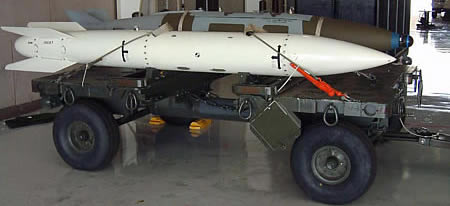 |
| The B61 (front, white) is similar in size to the JDAM (back). All high-yield B61-7s are stored in the United States. Image: USAF |
.
Moreover, the total number of B61-12s to be produced is far lower than the combined number of B61 versions in today’s stockpile – perhaps only around 400, down from an estimated 930 weapons.
Far less clear is how the agencies have determined that the risk of theft of a B61 has increased so much after September 2001 that too much HEU is deployed and existing safety and security features are inadequate to protect the weapons. Not least because a National Academy of Sciences task force recently concluded that “there is no comprehensive analytical basis for defining the attack strategies that a malicious, creative, and deliberate adversary might employ or the probabilities associated with them.” As a result, the task force concluded that it “could not identify how to assess the types of attacks that might occur and their associated probabilities.”
That doesn’t seem to have dampened NNSA’s pursuit of exotic safety and security features for all U.S. nuclear warheads in the name of an increased threat. Ironically, in doing so, NNSA is following White House guidance from 2003 that ordered “incorporation of enhanced surety features independent of any threat scenario” (emphasis added). Apparently, increased surety is not needed because of a specific increased threat but because of a policy.
But no one seems to be asking whether the B61 bombs in Europe are being exposed to unnecessary risks because the Air Force continues to scatter them in underground vaults underneath dozens of aircraft shelters at airbases in five European countries with different security standards; the deployment itself may add to the insecurity of the weapons.
The End of U.S. Non-Strategic Warheads
The B61-12 program marks the end of the 60-year old practice of the U.S. military to have designated non-strategic or tactical nuclear warheads in the stockpile. The only other remaining non-strategic warhead in the stockpile, the W80-0 for the nuclear Tomahawk Land-Attack Cruise Missile (TLAM/N), is also being eliminated.
| A “Tactical” Nuclear Weapons Phase-Out |
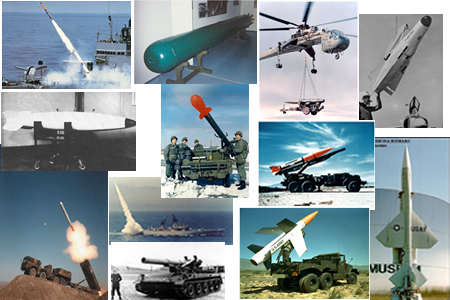 |
| The B61 LEP eliminates the last designated non-strategic (tactical) nuclear warheads from the U.S. stockpile, a category of warheads that used to dominate the U.S. arsenal, making the disparity with Russia’s non-strategic nuclear weapons a non-issue. |
.
With the elimination of the last non-strategic bombs (B61-3, -4 and -10), the B61-4 will be converted to meet the mission requirement of the B61-7; essentially, the non-strategic B61-4 will become a strategic bomb. The B61-12 will be carried by both long-range bombers and short-range fighter-bombers; strategic or non-strategic will be determined by the delivery platform rather than the warhead designation.
Ironically, eliminating non-strategic nuclear warheads and instead using strategic warheads in support of NATO actually meets the language of the Alliance’s new Strategic Concept, which states that “The supreme guarantee of the security of the Allies is provided by the strategic nuclear forces of the Alliance” rather than non-strategic bombs (emphasis added).
Implications and Recommendations
The B61 LEP appears to be much more than a simple life-extension of an existing warhead but an upgrade that will also increase military capabilities to hold targets at risk with less collateral damage.
It is perhaps not surprising that the nuclear laboratories and nuclear warfighters will try to use warhead life-extension programs to increase military capabilities of nuclear weapons. But it is disappointing that the White House and Congress so far have not objected.
The NPR clearly states that, “Life Extension Programs…will not…provide for new military capabilities.” I’m sure we will hear officials argue that the B61 LEP doesn’t provide new military capabilities because it doesn’t increase the warhead yield beyond the maximum of the existing four types.
But this narrow interpretation misses the point. Mixing precision with lower-yield options that reduce collateral damage in nuclear strikes were precisely the scenarios that triggered opposition to PLYWD and mini-nukes proposal in the 1990s. Warplanners and adversaries could see such nuclear weapons as more useable allowing some targets that previously would not have been attacked because of too much collateral damage to be attacked anyway. This could lead to a broadening of the nuclear bomber mission, open new facilities to nuclear targeting, reinvigorate a planning culture that sees nuclear weapons as useable, and potentially lower the nuclear threshold in a conflict.
Such concerns ought to be shared by the Obama administration, which has pledged to reduce the role of nuclear weapons and work to prevent that nuclear weapons are ever used. The pledge to reduce the role of nuclear weapons has received widespread international support but will fall flat if one of the administration’s first acts is to increase the capability of nuclear weapons.
How Russia and NATO allies will react remain to be seen, but increasing NATO’s nuclear capabilities at a time when the United States is trying to engage Russia in talks about limiting non-strategic nuclear weapon seems counterproductive.
These talks could become more complicated because the B61 LEP eliminates non-strategic nuclear warheads from the U.S. stockpile and instead leaves the B61-12 to cover both strategic and non-strategic scenarios. That will further blur the line between strategic and non-strategic weapons and make it a challenge to meet the U.S. Senate’s requirement “to initiate…negotiations with the Russian Federation on an agreement to address the disparity between the non-strategic (tactical) nuclear weapons stockpiles of the Russian federation and of the United States and to secure and reduce tactical nuclear weapons in a verifiable manner.” After the B61 LEP the United States will not have any non-strategic nuclear warheads to negotiate with, essentially making the “disparity” a non-issue.
NATO declared in its Strategic Concept from November 2010 that the alliance “will seek to create the conditions for further reductions in the future” of the number and reliance on nuclear weapons. Increasing the capability of NATO’s nuclear posture appears to contradict that pledge and could lead to increased opposition to continued deployment of U.S. nuclear weapons in Europe.
At the very least, the administration and Congress need to define and publicly clarify what constitutes “new capabilities.” More than $213 billion are planned for nuclear modernizations in the next decade; it’s hard to believe that there will be no “new capabilities” slipping through in that work. In fact, current plans for warhead life-extension programs indicate that the nuclear establishment intends to take full advantage of the uncertainly by increasing the targeting capabilities of the nuclear weapons: it is already happening with the W76 LEP, which is being deployed on submarines with increased targeting capability; it is scheduled to happen with the B61 LEP; and it appears to be planned for the W78 LEP as well.
The logic seems to be: “We’re reducing the number of weapons so of course the remaining ones have to be able to cover more scenarios.” In other words, the price for arms control is increased military capabilities.
The administration should also direct that the portion of the B61-12s that are earmarked for deployment in Europe be deployed without the new guidance tail kit but retain the accuracy of the exiting weapons currently deployed in Europe. Otherwise the B61-12 should not be deployed in Europe.
Finally, the administration’s ongoing nuclear targeting review should narrow the role of nuclear weapons to prevent that numerical reductions become a justification for increasing the capabilities of the remaining weapons. The new guidance must depart from the “warfighting” mentality that still colors nuclear war planning and is so vividly illustrated by the precision low-yield options offered by the B61-12.
NOTE: This blog is also available in PDF format as an Issue Brief.
This publication was made possible by a grant from Carnegie Corporation of New York and Ploughshares Fund. The statements made and views expressed are solely the responsibility of the author.
The B61 Life-Extension Program: Increasing NATO Nuclear Capability and Precision Low-Yield Strikes
A modified U.S. nuclear bomb currently under design will have improved military capabilities compared with older weapons and increase the targeting capability of NATO’s nuclear arsenal. The B61-12, the product of a planned 30-year life extension and consolidation of four existing versions of the B61 into one, will be equipped with a new guidance system to increase its accuracy. As a result, the U.S. non-strategic nuclear bombs currently deployed in five European countries will return to Europe as a life-extended version in 2018 with an enhanced capability targets.
Upsetting the Reset – The Technical Basis of Russian Concern Over NATO Missile Defense
The Obama administration is working with NATO to develop a missile defense shield to protect U.S. and European interests from ballistic missile attacks by Iran. Russian President Dmitry Medvedev has expressed strong concerns over this shield and has warned of a return to Cold War tensions, as well as possible withdrawal from international disarmament agreements like the New Strategic Arms Reduction Treaty (START).
On June 9, the NATO-Russia Council plans to meet with defense ministers to establish cooperation guidelines for the new European antiballistic missile system. The Federation of American Scientists (FAS) is releasing a new report that addresses concerns made by officials of the Russia Federation and provides recommendations for moving forward with a missile defense system..
Dr. Yousaf Butt, Scientific Consultant to FAS, and Dr. Theodore Postol, Professor of Science, Technology and National Security Policy in the Program in Science, Technology, and Society at the Massachusetts Institute of Technology, have published a technical assessment (PDF) of the Phased Adaptive Approach (PAA) missile defense system proposed by NATO and the United States and analyzed whether the Russian Federation has a legitimate concern over the proposed NATO-U.S. missile defense shield.
In practice the PAA will provide little, if any, protection leaving nuclear deterrence fundamentally intact. While the PAA would not significantly affect deterrence, it may be seen by cautious Russian planners to impose some attrition on Russian warheads. While midcourse missile defense would not alter the fundamental deterrence equation with respect to Iran or Russia, it may, in the Russian view, constitute an infringement upon the parity set down in New START.
